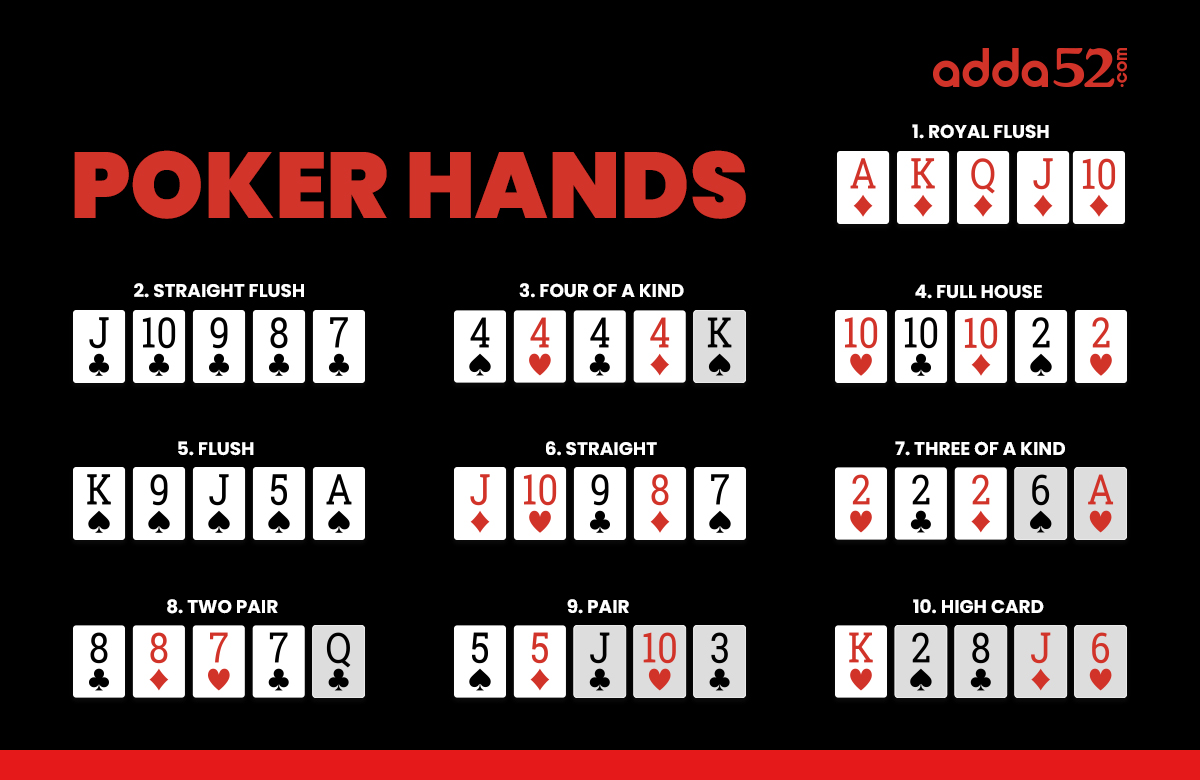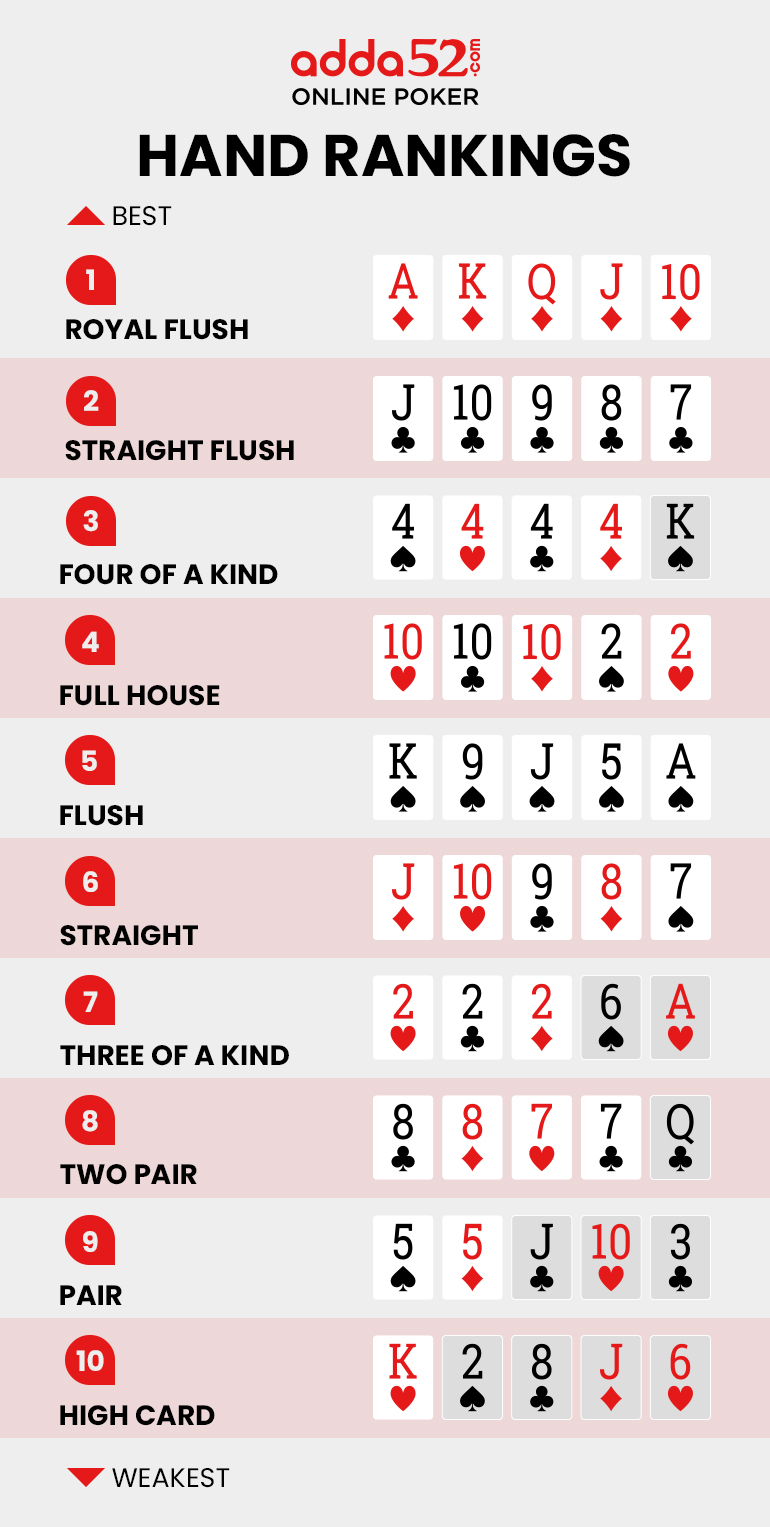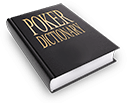Poker Hands - What Beats What?

Poker hands are a collection of a total of 5 cards made out of 2 hole cards and 5 community cards which are dealt during a game. These hands are ranked from high to low based on their relative hand strength.
The first step in a poker journey is to learn poker hand ranking. Learning about poker hands is pivotal in helping a player win the game.
In this blog, we will give you a complete list of poker hands and their relative strength. Starting with the highest hand, we will explain how to make one and what can beat your hand.
Royal Flush
The Royal Flush is the strongest poker hand on the table. This is a dream hand for all poker players. To benefit from it, you will have to influence others to bet more to increase the pot value. This will help you win larger stacks.

How to make a Royal Flush?
Combine all face cards with Ace and 10 of the same suit to make a Royal Flush.
Example: A♦ K♦ Q♦ J♦ 10♦ is a Royal Flush as all the cards are from the same suit with the A-K-Q-J-10 combination.
How strong is a Royal Flush?
Royal flush beats all other hands on the poker table.
Straight Flush
A Straight Flush is the second-strongest poker hand on the table, coming second only to the Royal Flush. If Two Players Have The Same Hand Rank As A Straight Flush, Then The Higher Ranking Straight Flush Would Win The Pot.

How to make a Straight Flush?
You make a Straight Flush hand by combining five consecutive cards of the same suit.
Example: 10♠ 9♠ 8♠ 7♠ 6♠. Here, all 5 cards are in sequence and are of the same suit.How strong is a Straight Flush?
Coming second only to the Royal Flush, Straight Flush beats all other hands except Royal Flush.
Four-of-a-Kind
Four-of-a-Kind is the third strongest poker hand on the table. As the word says, Four of a kind consists of 4 cards of one rank. To make it a 5-card hand, you can use any card as the fifth card, irrespective of its rank and suit. The fifth card is called a Trump Card. In case of a tie, the player with the highest ranking Four-of-a-Kind wins the pot.

How to make a Four-of-a-Kind?
To make a Four-of-a-Kind hand, you need to combine four cards of the same rank and the fifth card can be any one of the cards from the deck.
Example: J♦ J♣ J♠ J♥ K♦. Here you have 4 J’s which makes a Four-of-a-Kind hand.
How strong is a Four-of-a-kind?
A Four-of-a-kind is the third strongest poker hand that can beat a Full House, Flush, Straight, Three-of-a-kind, Two Pair, a Pair, and a High card.
Full House
Full House is the fourth strongest hand on the poker table. A full house is the combination of three cards of one rank(Three-of-a-Kind) and one pair of cards of any other rank. In case of a tie, the player with the higher ranking Three-of-a-Kind wins. In case, Three-of-a-Kind is also the same for two players, then the player with a higher Pair will win the pot.

How to make a Full House?
You make a Full House hand with three cards of one rank(Three of a Kind) and another pair of some other rank.
Example: A♥ A♣ A♦ 7♠ 7♣. Here you have three Aces and one pair of 7’s to complete a Full House hand
How strong is a Full House?
The fourth-best poker hand, the Full House can beat a Flush, Straight, Three-of-a-kind, Two Pair, a Pair, and a High card.
Flush
A Flush is the fifth strongest hand on the poker table. A Flush is a Poker hand that has all five cards of the same suit. If there’s a tie, the player with the highest-ranking five cards wins. In the case of the same highest-ranking cards, the player with the second-highest card wins. If required, the third, fourth, and fifth highest-ranking cards can also be used to break the tie.

How to make a Flush?
A Flush is made with five cards of the same suit not necessarily in the same rank.
Example: 4♦ 3♦ 2♦ J♦ K♦. In this example, all 5 cards are of the same suit, hence it is a Flush.
How strong is a Flush?
A Flush is the fifth-best poker hand that can beat a Straight, Three-of-a-kind, Two Pair, a Pair, and a High card.
Straight
This is the sixth strongest hand on the poker table. A Straight is a poker hand that has five cards in a sequence, not all of the same suit. Ace can be treated as the highest(above King) or the lowest card(below 2), but not as both, in a Straight hand. In case of a tie, the player with the highest card wins. If both the players have same highest card, then the pot is equally divided amongst them.

How to make a Straight?
You make a Straight hand when you have five cards in a sequence, not necessarily of the same suit.
Example: 2♦ 3♣ 4♦ 5♠ 6♣. Here 2-3-4-5-6 are in a Straight sequence.
How strong is a Straight?
While the Straight might seem like a strong hand, it can only beat Three-of-a-kind, Two Pair, a Pair, and a High Card.
Three-of-a-Kind
Three-of-a-Kind is the seventh strongest hand on the poker table. Three-of-a-kind is a poker hand with a collection of three cards of the same rank and two unrelated cards. In case of a tie, the player with the higher rank Three-of-a-Kind wins the pot. So J-J-J-2-3 wins over 9-9-9-2-3 as the prior has a higher Three-of-a-Kind.

How to make a Three-of-a-Kind?
You make a Three-of-a-Kind hand with three cards of the same rank.
Example: 6♣ 6♦ 6♠ 2♣ K♦. Here you have three 6’s which makes a Three-of-a-Kind hand with the other two being any unrelated cards.
How strong is a Three-of-a-kind?
The 3-of-a-kind is stronger than the Two Pair, Pair, and the High Card.
Two Pair
Two Pair is the eighth strongest hand on the poker table. A Two Pair consists of the first pair of one rank and the second pair of another rank with the fifth card being from any other rank. In case of a tie, the person with the higher rank of Two Pair wins. If the Two Pairs are identical, then the person with a higher fifth card(from community/hole cards) wins the pot.

How to make a Two Pair?
To make a Two Pair hand, take two cards of the same rank, repeat the same with different ranks, and add one side card, which is not the same as the first two ranks.
Example: 5♦ 5♠ Q♦ Q♥ 2♣. As explained above, this combination has two pairs- one pair of 5 and another pair of Q.
How strong is a Two Pair?
The Two Pair is a strong enough poker hand to just beat the One Pair and the High card.
One Pair
One Pair is the ninth strongest hand on the poker table. A One Pair is the combination of only two cards of the same rank but different suits, while the rest of the three cards can be any cards from the deck. In the case of a tie, if players have the same ranked pairs, the highest of the other three cards is used to identify the winner.

How to make a One Pair?
You can form a One Pair hand by adding two cards of the same rank and three different cards to it.
Example: A♦ A♥ K♠ 9♦ 4♥. Here, this combination has just one pair of Ace and the other three cards are unrelated ones.
How strong is a One Pair?
A relatively common poker hand, the One Pair only beats the High Card.
High Card
The High Card is the lowest or the tenth strongest-ranked hand on the poker table. If no players on the table have any of the above-mentioned hands, then the player with the highest card wins the pot. In case more people have the same highest card, then the second highest card holder wins the pot. If the tie is still not resolved, the third, fourth, and fifth-highest cards are also considered to declare the pot winner.

How to make a High Card?
If you are unable to make any of the hands mentioned above, The highest rank card in your hand is called the High Card .
Example: 4♥ K♠ 9♦ 5♦ 7♠. Here, K♠ is your high card as this 5-card combination is unable to make any of the above-mentioned hands.
How strong is the High Card?
The High Card can only beat another high card with a lower rank. So a player with cards K-J-8-6-2 beats another player with cards Q-J-8-6-2 because the highest card of the first player is K which has higher strength than the Q card of the second player.

Conclusion
Understanding poker hands is essential for any player aiming to master the poker game. This article explains the poker hands from the highest card which is Royal Flush, to the lowest card which is High Card. Each poker hand is detailed with its composition and relative strength. The Royal Flush tops the list, followed by the Straight Flush, Four-of-a-Kind, Full House, Flush, Straight, Three-of-a-Kind, Two Pair, One Pair, and finally the High Card. Knowing these poker hand rankings can significantly enhance a player's strategy and decision-making, leading to greater success at the poker table.
Frequently Asked Questions
How are poker hands ranked with respect to their strength?
Here’s how the poker hands are ranked, from the highest to the lowest: Royal Flush, Straight flush, Four-of-a-kind, Full House, Flush, Straight, Three-of-a-kind, Two Pair, a Pair, and a High card.
What is a poker hand?
A poker hand is a combination of five cards that defines the strength of one’s hand. A poker hand is made of 2 hole cards and 3 community cards which are common to all the players on the table. Players must wager and aim to leverage their hands accordingly to win the game.
How many poker hands are there?
There are ten different poker hands ranked, from the highest to the lowest: Royal Flush being the highest hand followed by Straight flush, Four-of-a-kind, Full House, Flush, Straight, Three-of-a-kind, Two Pair, a Pair, and a High card being the lowest ranked hand.
What's the luckiest hand in poker?
Royal Flush is the best and the luckiest hand one can get in poker. It beats all other hands in the game.
